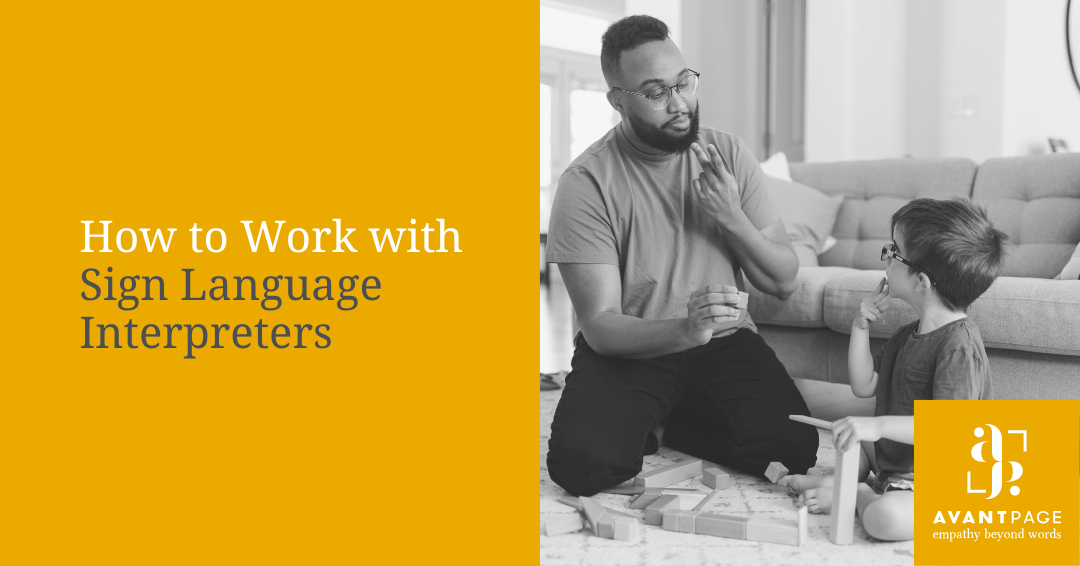A sign language interpreter communicates between people who are deaf or hard-of-hearing and those who have hearing. A sign language interpreter may be useful or required in many different settings, including healthcare, education, court, an office or other situations. The best way to find a qualified interpreter is to work with a professional interpreting service who will ensure all the needed requirements to meet regulatory compliance as well as meaningful language access.
If you’re going to learn how to work with a sign language interpreter for the first time, or if it’s been a while since you’ve worked with an interpreter, you may not know what to expect. We’ve put together the following list of tips so you can become familiar with the process and be prepared before and during the interaction.
How to Prepare to Work with a Sign Language Interpreter
Before the interpretation session, here are some things to know.
- The interpreter’s role is to communicate between people who are deaf or hard-of-hearing and those with hearing. An interpreter is bound by a strict Code of Professional Conduct such as the code established by the Registry of Interpreters for the Deaf. This Code ensures confidentiality, professionalism, and impartiality.
- It’s not uncommon for a sign language interpreter to seek out the individual who is deaf or hard-of-hearing to casually talk to assess their sign language skills before the interpretation. This helps establish a trusted rapport as well as helps the interpreter provide more meaningful language access.
- An interpreter will interpret everything, so don’t ask the interpreter to leave something out.
- Signing can be physically and mentally tiring. If there’s only one interpreter, that person may need breaks after 20-30 minutes depending on the type of interpretation. If there are two interpreters, they can relieve each other during regular intervals. The one who isn’t interpreting can then monitor the conversation and watch for things that may have been missed.
- Another type of interpretation in which there’s more than one interpreter is when a Certified Deaf Interpreter (CDI) works with a hearing sign language interpreter. In this case, a CDI works with an interpreter to handle dialects, sign languages, home signs, or other cultural differences to make sure the interpretation is precise.
- If you have any written materials that you plan to use during the session, provide the interpreter with a copy ahead of time. This will allow the interpreter to become familiar with the content and ask questions about the material, such as terminology.
- If you plan to show a video, check to see if it has closed captions. If the interpreter needs to interpret the video, understand this is a form of simultaneous interpretation and they would need to be aware in advance as well as may need breaks.
- If working with Video Remote Interpreting, the internet connection must be high quality for full visuals of signs. If you can use a hard-wired internet connection this will facilitate the best quality connection.
How to Work with an In-Person Sign Language Interpreter
Here are some tips on working with an in-person sign language interpreter in a classroom or large group setting.
- If the interpreter will be in a setting where you’ll be presenting in front of a group, make sure that the interpreter either has standing room or a seat facing the deaf person. Also, make sure there’s room for a chair, and it’s not too cluttered to move around.
- The person who is deaf or hard-of-hearing needs to sit in the front to see the speaker, a board or other visuals (if used), and the interpreter.
- If you plan to dim the lights, make sure the deaf person will still be able to see the interpreter.
- Don’t assume that an interpreter and a person who is deaf or hard-of-hearing already know each other or expect the same interpreter to be in future sessions.
- If there will be multiple speakers, advise them to pause before the next speaker speaks. This will allow the interpreter time to finish interpreting.
- Make sure you have contact information for the interpreter or the agency they represent in case anything changes prior to the meeting.
How to Work with an Interpreter During the Session
Here are some tips for how to work with an interpreter during the session.
- Allow extra time to meet the interpreter(s) and the person who is deaf or hard-of-hearing before the session begins.
- Make sure that the interpreter(s) is comfortable with the setting, such as having an extra 1-2 chairs available.
- During the session, look at and speak directly to the person who is deaf or hard-of-hearing, not the interpreter.
- Speak in your regular tone of voice at your natural pace. If needed, the interpreter will ask you to slow down.
- If the interpreter is remote and everyone else is physically together, make sure every person is audible by standing nearby the computer when speaking or using microphones.
- Relax. If you have questions, ask the interpreter.
Conclusion
Many situations require a sign language interpreter. Being prepared before and during the interaction should lead to a more successful outcome for everyone.
We provide interpretation services for all types of industries, and we’d be happy to answer any questions you might have about how the process work. To learn more, contact us at [email protected] or (530) 750-2040.
reSources for working with sign language interpreters:
Working with Sign Language Interpreters
Tips for working with Sign Language Interpreters
10 Tips for Using a Sign Language Interpreter
